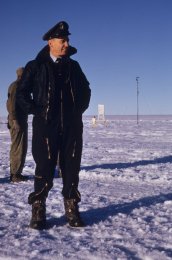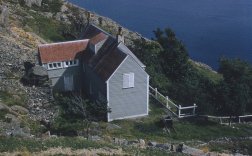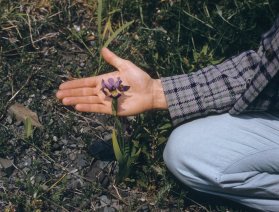
Billy spent the last half of 1953, and all of 1954, in a much different climate than he was used to in Texas. He was based in St. John's, Newfoundland, with the Northeast Air Command (NEAC), for this period. We unfortunately have no documentation about how the "Arctic Sojourn" came about, although it seems logical that he would at least have had to agree to this rather extreme duty. Did he even volunteer for it?
 The NEAC assignment doubtless offered opportunities for a young officer to burnish his resume. But whatever career-advancing advantages it might have presented, going by some of the letters Billy wrote from Canada, he was somewhat ambivalent about the wisdom of spending so much time away from his family. He missed them and swore never to agree to such a long separation again. We even have a tape recording of a farewell dinner he attended, and he remarked that his only regrets about the assignment were that his wife and girls had not been with him.
The NEAC assignment doubtless offered opportunities for a young officer to burnish his resume. But whatever career-advancing advantages it might have presented, going by some of the letters Billy wrote from Canada, he was somewhat ambivalent about the wisdom of spending so much time away from his family. He missed them and swore never to agree to such a long separation again. We even have a tape recording of a farewell dinner he attended, and he remarked that his only regrets about the assignment were that his wife and girls had not been with him.
(However, fortunately for us now, the separation meant that letters were written, and the fact that we have at least some of these means that we have a much fuller picture of the time he spent in Newfoundland than any other period of his postwar service.)
This page gives some of the highlights of Billy's "Arctic Sojourn" and describes the potentially life-changing decisions he made there about his and his family's future. The Timeline will give more details about minor trips and other activities that occupied him during this tour, information gleaned from official papers, remarks in his letters, and photo captions. More detailed information about his major trips to Greenland are here: Project Mint Julep • Exercise Windchill
The Letters tab above leads to links to scans, along with transcribed excerpts from this correspondence that gives us more details about his thoughts while spending time so far away from his family.
Here are some interesting papers from this period:
- "Checklist for personnel processing for overseas shipment," dated March 27
- Assignment for transport aboard the USNS Gen. H.D. Hodges; also to 6600th Air Base Group, NEAC; dated April 29
- Personal History form that details his education and service up to May, 1953; apparently a scratch copy, filled in pencil
- Leave of 30 days granted, dated December 1
- Personal equipment receipt, initialed and dated March 4, 1954
- Temporary promotion to Major, dated May 13, 1954
- Top Secret clearance to observe Operation Gold Cup, in Gander, Newfoundland, dated September 29 (I was not able to find any information about this operation)
- Top Secret clearance to coordinate operational matters in connection with Project High Flight at Narsarssuak AFB, Greenland, dated September 30 (I was also not able to find any definite information about this operation)
- Official promotion to Major, dated October 1

Billy’s home base during the 18 months he spent in the Arctic was Pepperrell AFB in St. John’s, Newfoundland. The air base no longer exists, but the space that it occupied, and some of its original buildings, have been put to good use by the city, and there is a small Canadian defense installation there as well.
 The Newfoundland part of the Canadian province of Newfoundland/Labrador is an island, cut by many bays and inlets, with a rocky coast. Billy was able to visit various parts of the island. Thanks to Google Earth and the photos that were labelled, we were able to identify many of the locations of the photos, although a few remain tantalizingly unidentified. See a sample of these photos here; many more, includingn larger images of some of the photos on the webpages, are in these Flickr Albums: Arctic Sojourn • Arctic Sojourn: Scenery.
The Newfoundland part of the Canadian province of Newfoundland/Labrador is an island, cut by many bays and inlets, with a rocky coast. Billy was able to visit various parts of the island. Thanks to Google Earth and the photos that were labelled, we were able to identify many of the locations of the photos, although a few remain tantalizingly unidentified. See a sample of these photos here; many more, includingn larger images of some of the photos on the webpages, are in these Flickr Albums: Arctic Sojourn • Arctic Sojourn: Scenery.
One of the most interesting places he visited, and where he took many photos, was a house near Brigus, on the other side of Conception Bay from St. John's. See one of the photos here on the left, more in the Photo Gallery and even more in the Flickr set. It was formerly the home of a Canadian artist, Rockwell Kent (according to the note on one of Billy's photos) and was bought in 1953 by Jake Folensbee, an American artist and educator who was responsible for founding the Landfall Trust, which now oversees the restored cottage that Billy visited, and its surrounding acreage. It was very exciting for me to discover that Billy visited this special place so early in its history, and must have been friends with Mr. Folensbee.
Just six weeks after arriving in Newfoundland, Billy embarked upon an exciting trip to Greenland in the far arctic, during which time he visited the site of the Mint Julep project. A large boon to our knowledge about this trip is a write-up Billy sent to June in late July of 1953. Another trip to Greenland happened in 1954, in conjunction with Exercise Windchill, and he wrote about that, too, although not in as much detail.
 Unfortunately, only a few of the offical papers we have from this time give us much information on what Billy did in Newfoundland. We know that he sailed from Brooklyn Navy Yard on the General H.D. Hodges and arrived at Pepperrell on May 8, 1953. And in October, he attended a meeting in Alabama about Project Mint Julep. (This paper gave us the clue needed to unearth all the information we have about this interesting endeavor; it is not mentioned by name in any other papers or in Billy's letters.)
Unfortunately, only a few of the offical papers we have from this time give us much information on what Billy did in Newfoundland. We know that he sailed from Brooklyn Navy Yard on the General H.D. Hodges and arrived at Pepperrell on May 8, 1953. And in October, he attended a meeting in Alabama about Project Mint Julep. (This paper gave us the clue needed to unearth all the information we have about this interesting endeavor; it is not mentioned by name in any other papers or in Billy's letters.)
Though many 1953 letters are evidently lost, we have many from 1954 that outlined more of his activities. He spent some boring time as a duty officer, checking to be sure everything stayed locked up during the night. But he also got to take some trips around the island by car and plane. There are references to these excursions in the letters, and some of his photos are labelled with Newfoundland place names.
One big trip he made seems to have been to Winter Survival School in Labrador; there are slides that indicate this, but there is no mention of the assignment in any papers, or a discussion of it in letters. We do have evidence, however, of another trip to Greenland, for the Windchill exercise, in 1954; it's mentioned in letters before the trip and he did a short write-up similar to his Mint Julep report. 
As mentioned above, during his time in Newfoundland Billy at least considered leaving the service and returning to academia. We have copies of correspondence written during 1954 indicating that he had been offered an assistantship in the botany department at Louisiana State University, but was unsure about whether to take it or remain in the Air Force. Unfortunately the paper record of this period of indecision is incomplete; we don’t know whether he initiated contact with LSU or if they got in touch with him. And we don’t know much more about his thoughts in contemplating this career change. See the correspondence dealing with this big decision here. And here are a few official papers, some of which are probably pro forma, that might shed some light on it:
- Application for release from active duty in 21 months, dated June 8, 1953
- Change of service commitment from "indefinite" to April, 1955; dated June 10, 1953
- Commitment to remain on active duty indefinitely, dated June 18, 1954
However, of course, he decided to stay in the service rather than return to civilian academic life. How different our lives might have been had this decision point gone the other way!
 Did he decide to stay in the Air Force out of a sense of duty to his country, the promise of a subsequent interesting and exciting assignment, worry about finances, or some other reasons that were not recorded in letters or official paperwork? Did his promotion to Major, which happened around this same time (summer, 1954) factor into his decision? We will never really know, but can only speculate.
However conflicted Billy felt about his time in Newfoundland, it was definitely an exciting experience, offering opportunities for travel in a part of the world that he had seen briefly in 1943:
Did he decide to stay in the Air Force out of a sense of duty to his country, the promise of a subsequent interesting and exciting assignment, worry about finances, or some other reasons that were not recorded in letters or official paperwork? Did his promotion to Major, which happened around this same time (summer, 1954) factor into his decision? We will never really know, but can only speculate.
However conflicted Billy felt about his time in Newfoundland, it was definitely an exciting experience, offering opportunities for travel in a part of the world that he had seen briefly in 1943:
“The place did things to you with all its rugged beauty. It gave you the feeling of strength and I immediately put it on my list of places I hope to see again in peace time.” [from the Journal]
Part of his enjoyment in the experience was still related to his love for science, and especially botany. He took a few photos of some of the arctic flora, (see one on the left) and, during his first trip to the Greenland ice cap, he mentions how intriguing he found the scientific aspects of the operations underway there—Operation Mint Julep, which was a joint scientific and military mission.
Whatever his misgivings about continuing in the Air Force, and whatever his desires to return to a life of academics and science, we know no more about them than the tantalizing tidbits in these letters.
